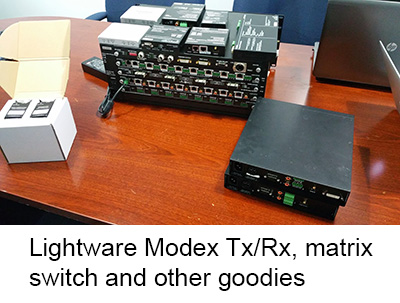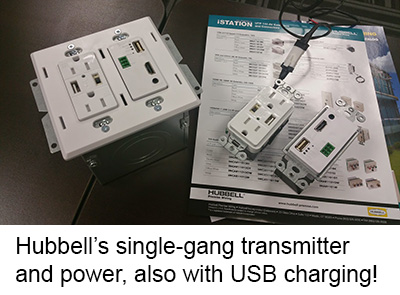Fun with HDBaseT
HDBaseT has been described as a bridge technology between traditional video transport and IP-based systems, the time for which is rapidly arriving. It’s a technology about which I’ve not been excited for some time; every manufacturer not only uses the same chipset (produced by Valens), but appears to have settled on the same form-factor and product line. There’s the standalone transmitter, the standalone receiver (with or without scaling), a two-gang, wall-plate transmitter with VGA and HDMI, a single-gang HDMI-only transmitter, and card-based modular matrix switches in 8×8, 16×16, 32×32, 64×64 and sometimes 128×128 sizes. Are there any innovations to be had in this realm and, more importantly, do they matter? To answer the first question, there are three products I’ve seen recently which I find interesting. As to whether or not they matter, time will tell. At present there is still enough need for point-to-point transport that HDBaseT types of solutions can have a place either in place of IP-based systems (for small, single-room systems) or as part of a hybrid system (for larger deployments).
Lightware
 I had the pleasure of meeting the Lightware team last month here at Primeview’s showroom in New York City. In addition to having the foresight to build their matrix switches with a high enough bandwidth backplane for 4K content, Lightware has a few interesting quirks. One is that their matrix frames each have a single local input and output, sizing them at 9×9, 17×17, etc rather than the traditional 8×8 or 16×16. It’s a very minor point, but one that has the possibility to save design headaches in those rare, specific situations in which one has, for example, a ninth input and doesn’t want to move up to the next size frame. More practically, because it’s a local-only output it creates an easy connection point for a rack-mounted monitor. Nice? Yes. Groundbreaking? Not really.
I had the pleasure of meeting the Lightware team last month here at Primeview’s showroom in New York City. In addition to having the foresight to build their matrix switches with a high enough bandwidth backplane for 4K content, Lightware has a few interesting quirks. One is that their matrix frames each have a single local input and output, sizing them at 9×9, 17×17, etc rather than the traditional 8×8 or 16×16. It’s a very minor point, but one that has the possibility to save design headaches in those rare, specific situations in which one has, for example, a ninth input and doesn’t want to move up to the next size frame. More practically, because it’s a local-only output it creates an easy connection point for a rack-mounted monitor. Nice? Yes. Groundbreaking? Not really.
The other item of which they are proud is their Modex line of HDBaseT extenders. This is an interesting mix-and-match concept in that the standalone transmitter and receiver boxes are populated by modules; one for copper or fiber transport, one for audio or video inputs, etc. This allows one to purchase units with exactly the desired connectivity. Sadly, the modules are neither user-swappable nor available for purchase a la carte. If they were, it would be an intriguing way for contractors to create a transport “toolkit” in which they mix-and match modules on the fly for specific purposes. Hopefully this will come someday.
Hubbell
 While I tend to think of Hubbell as an architectural connectivity company rather than a source of electronics, they do have an AV division producing active devices, including HDBaseT extension. Their “110 AV” line is interesting in that, unlike other AV over twisted pair transport, they connect via 110 punchdown blocks rather than RJ45 jacks. This is more in line with BICSI wiring standards (as well as common practices by teledata contractors), which indicate that field cable is NOT to be terminated to a male connector. In fact, the only people one is likely to see field-terminating UTP are audiovisual contractors. This not only creates a potential failure point, but makes packaging AV wiring with the rest of the structured cable contract a challenge.
While I tend to think of Hubbell as an architectural connectivity company rather than a source of electronics, they do have an AV division producing active devices, including HDBaseT extension. Their “110 AV” line is interesting in that, unlike other AV over twisted pair transport, they connect via 110 punchdown blocks rather than RJ45 jacks. This is more in line with BICSI wiring standards (as well as common practices by teledata contractors), which indicate that field cable is NOT to be terminated to a male connector. In fact, the only people one is likely to see field-terminating UTP are audiovisual contractors. This not only creates a potential failure point, but makes packaging AV wiring with the rest of the structured cable contract a challenge.
Speaking of wall plates, they have taken advantage of their line of power receptacles to create what stands out in my mind as the most clever means of locally powering a wall plate device. They’ve modified one of their standard duplex receptacles with a low-voltage DC pigtail to run into the back of a single-gang wall plate HDMI transmitter. Both transmitter and receptacle can then be mounted together in a custom two-gang wall box with an integrated low-voltage divider. It’s a neat way to combine device power with video transport.
Hubbell’s weakness here is that they lack the scope of most other participants in this market segment; they have perfectly reasonable point-to-point transmitters and receivers, but lack the matrix switches, scalers, and other units we’d expect from a more AV-centric manufacturer. They’ve also, as of yet, not done enough homework on interoperability to be able to tell us which display manufacturer’s integrated HDBaseT receivers with which their transmitters will work. This, sadly, limits their usefulness.
Crestron
This is the one item I’ve not physically gotten my hands on, but it’s an interesting one. Crestron has, for some time, offered a two-channel H.264 transmitter as an output card for its modular matrix switches. I have used this, and it does what one would expect it to. The part that I’ve not played with yet is a corresponding H.264 streaming input card. This is useful for system designs utilizing point-to-point transport within a room and the addition of streaming to share content across spaces. It’s the kind of solution that can give HDBaseT longer legs.
The Future?
The folks at Valens tell me that the HDBaseT chipset has capabilities not yet being used, including the ability to divide available video bandwidth into separate video channels. This may or may not be useful; I still see complicated systems as more likely to be handled over IP in the future.





